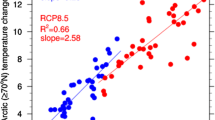Abstract
This paper examines several prominent thermodynamic and dynamic factors responsible for the meridional and vertical warming asymmetries using a moist coupled atmosphere–surface radiative transportive four-box climate model. A coupled atmosphere–surface feedback analysis is formulated to isolate the direct response to an anthropogenic greenhouse gas forcing from individual local feedbacks (water vapor, evaporation, surface sensible heat flux, and ice-albedo), and from the non-local dynamical feedback. Both the direct response and response to water vapor feedback are stronger in low latitudes. The joint effect of the ice-albedo and dynamical greenhouse-plus feedbacks acts to amplify the high latitude surface warming whereas both the evaporation and dynamical greenhouse-minus feedbacks cause a reduction of the surface warming in low latitudes. The enhancement (reduction) of local feedbacks in high (low) latitudes in response to the non-local dynamic feedback further strengthens the polar amplification of the surface warming. Both the direct response and response to water vapor feedback lead to an increase of lapse rate in both low and high latitudes. The stronger total dynamic heating in the mean state in high latitudes is responsible for a larger increase of lapse rate in high latitudes in the direct response and response to water vapor feedback. The local evaporation and surface sensible heat flux feedbacks reduce the lapse rate both in low and high latitudes through cooling the surface and warming the atmosphere. The much stronger evaporation feedback leads to a final warming in low latitudes that is stronger in the atmosphere than the surface.










Similar content being viewed by others
References
Alexeev VA, Langen PL, Bates JR (2005) Polar amplification of surface warming on an aquaplanet in “ghost forcing” experiments without sea ice feedbacks. Clim Dyn 24:655–666
Bates JR (1999) A dynamical stabilizer in the climate system: a mechanism suggested by a simple model. Tellus 51A:349–372
Bony S et al. (2006) How well do we understand and evaluate climate change feedback processes? J Clim 19:3445–3482
Cai M (2005) Dynamical amplification of polar warming. Geophys Res Lett 32 L22710. doi:10.1029/2005GL024481
Cai M (2006) Dynamical greenhouse-plus feedback and polar warming amplification. Part I: a dry radiative-transportive climate model. Clim Dyn 26:661–675
Cess RD et al (1990) Intercomparison and interpretation of cloud-climate feedback processes in nineteen atmospheric general circulation models. J Geophys Res 95:16601–16615
Clement A, Seager R, Cane MA, Zebiak SE (1996) An ocean dynamical thermostat. J Clim 9:2190–2196
Hall A (2004) The role of surface albedo feedback in climate. J Clim 17:1550–1568
Hall A, Qu X (2006) Using the current seasonal cycle to constrain snow albedo feedback in future climate change. Geophys Res Lett 33, L03502. doi:10.1029/2005GL025127
Hartmann DL (1994) Global physical climatology. Academic, New York, pp 231–336
Hartmann DL, Michelsen ML (1993) Large-scale effects on the regulation of tropical sea surface temperature. J Clim 6:2049–2062
Hassol SJ (2004) Impacts of a warming arctic: arctic climate impact assessment. Cambridge University Press, Cambridge, p 146
Held IM, Soden BJ (2000) Water vapor feedback and global warming. Ann Rev Energy Environ 25:441–475
Hoffert MI, Covey C (1992) Deriving global climate sensitivity from palaeoclimate reconstructions. Nature 360:573–576
Holland MM, Bitz CM (2003) Polar amplifications of climate change in coupled models. Clim Dyn 21:221–232
Houghton JT et al (2001) Climate change 2001: the scientific basis. Cambridge University Press, Cambridge, pp 101–181
Masson-Delmotte V et al (2006) Past and future polar amplification of climate change: climate model intercomparisons and ice-core constraints. Clim Dyn 26:513–529
Meehl GA, Washington WM, Santer BD et al. (2006) Climate change projections for the twenty-first century and climate change commitment in the CCSM3. J Clim 19:2597–2616
Newell RE (1979) Climate and the ocean. Am Sci 67:405–416
North GR (1975) Theory of energy-balance climate models. J Atmos Sci 32:2033–2043
Pierrehumbert RT (1995) Thermostats, radiator fins, and the local runaway greenhouse. J Atmos Sci 52:1784–1806
Pierrehumbert RT (2002) The hydrological cycle in deep-time climate problems. Nature 419:191–198
Ramanathan V, Collins W (1991) Thermodynamic regulation of warming by cirrus clouds deduced from observations of the 1987 El Nino. Nature 351:27–32
Schneider EK, Kirtman BP, Lindzen RS (1999) Tropospheric water vapor and climate sensitivity. J Atmos Sci 56:1649–1658
Shine KP, Sinha A (1991) Sensitivity of the earth’s climate to height dependent changes in the water vapor mixing ratio. Nature 354:382–384
Soden BJ, Held IM (2006) An assessment of climate feedbacks in coupled ocean-atmosphere models. J Clim 19:3354–3360
Sun, D-Z, Liu Z (1996) Dynamic ocean–atmosphere coupling: a thermostat for the tropics. Science 272:1148–1150
Zhang MH, Hack JJ, Kiehland JT, Cess CD (1994) Diagnostic study of climate feedback processes in atmospheric general circulation models. J Geophys Res 99:5525–553
Acknowledgement
We are grateful for the constructive and valuable comments made by Ed Schneider, Peter Langen and an anonymous reviewer. This work was supported in part by NSF grants ATM-0403211 and ATM-0424799.
Author information
Authors and Affiliations
Corresponding author
Rights and permissions
About this article
Cite this article
Cai, M., Lu, J. Dynamical greenhouse-plus feedback and polar warming amplification. Part II: meridional and vertical asymmetries of the global warming. Clim Dyn 29, 375–391 (2007). https://doi.org/10.1007/s00382-007-0238-9
Received:
Accepted:
Published:
Issue Date:
DOI: https://doi.org/10.1007/s00382-007-0238-9




